The Future of Conversational AI For Enterprise Companies
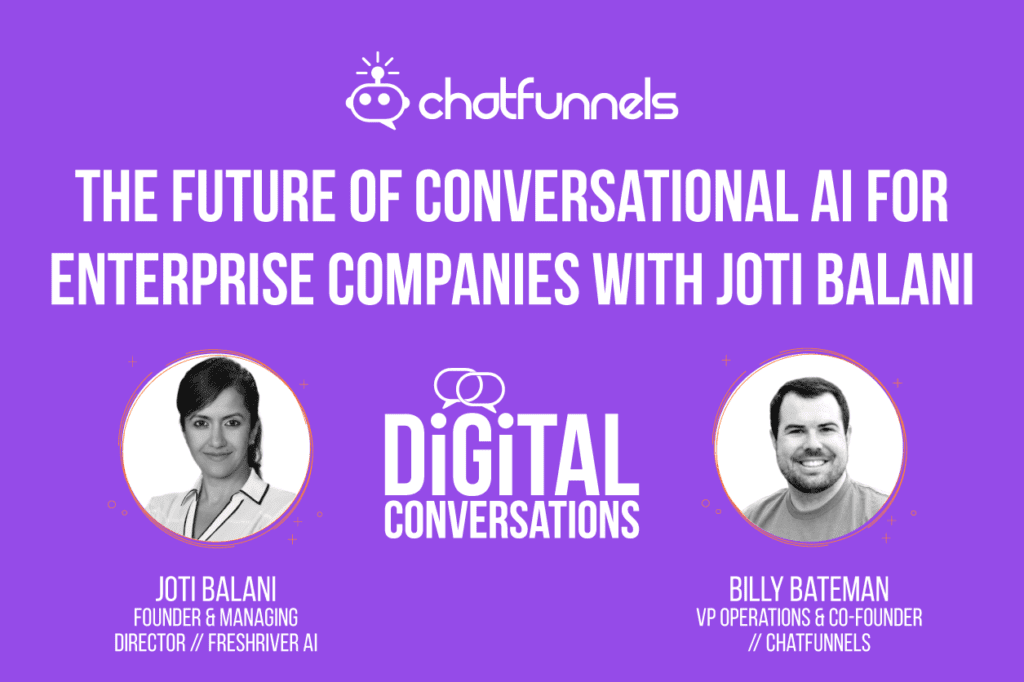
Reading Time: 20 minutes
Overview:
This week on digital conversations with Billy Bateman we are featuring Joti Balani, Managing Director and founder of Freshriver AI. She discusses the growth of conversational AI and its use cases for enterprise companies.
Guest- Joti Balani: Joti is Founder and Managing Director at Freshriver AI. She has previously worked for Citigroup and American Red Cross as a Chatbot Consultant. She has expansive knowledge of modern cloud, digital and data analytics technologies, as well as SaaS/IaaS, B2C/B2B and multi-industry ecosystems. Connect with Joti on LinkedIn.
Listening Platforms:
data:image/gif;base64,R0lGODlhAQABAAAAACH5BAEKAAEALAAAAAABAAEAAAICTAEAOw==
Transcript:
Billy: All right, everyone, welcome to the show today. Today I have the pleasure of being joined by Joti Balani, Founder and Managing Director at Freshriver AI. Thanks for joining us today. Jody.
Joti: Thank you, Billy. Excited to be here.
Billy: Yeah, I’m really excited for this. It’s going to be a great conversation, diving into designing conversational experiences and deployments for enterprise companies. But before we get into that, would you just introduce yourself to the audience, a little bit about yourself, your background, and how you got into conversational AI?
Introduction to Joti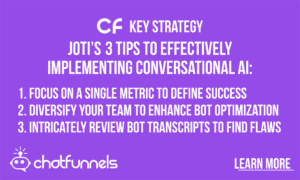
Joti: Sure. So I actually see the world in three dimensions. I claim to be the queen of pivot unless somebody else claims that title. But I started out my career as a software engineer. I then moved on to product development, product management and did marketing for a couple of years. And I also pivoted industries from the telecom cloud infrastructure industry into, Of course now, conversational AI. It’s been quite a ride. So I’m all in for the last about two years in the AI space, specifically conversational AI. And data science is coming right up behind it.
Billy: Awesome. Awesome. And then how did you get into Freshriver? What was the genesis behind it? You know, how’d you get started there?
Joti: Sure. So, I always love riding the emerging tech waves, usually you can smell things coming on. You know, I’ve been watching AI ever since even the days that I did computer science, it was always in the labs. It was around, I would say 2018 timeframe. I was heading marketing for a consulting company, the digital analytics and cloud space, that I started to realize that enterprises are now taking really close notice of use cases in artificial intelligence.
And I was helping write use cases for the product team. And that’s when I said, well, this is this has got to be the next wave that’s coming in. Fortunately for me, it was happenstance, I was I was helping, actually my husband’s company, who had helped on and off with product and marketing. They were adding voice to their health care platform. And that’s when I discovered voice is where things are beginning to pick up.
Obviously at that time, there was you know, Alexa and Google Assistant, all these were getting deployed in homes. But for the enterprise, that’s when it started getting real. And from that point on, I started taking on consulting projects. I did work for the Red Cross, for Citigroup, I started to speak at conferences and there was a framework that I had developed over the last many years being in another industry that I brought into here.
And of course, you know, learned what it means to be in conversational AI. So I can, you know, the reason why the framework’s important to me is I can speak to, you know, business users trying to figure out what problem to solve, you know, conversational AI is not going to solve everything. But what are the key things you can solve, all the way to working with developers, because I have software engineering in my background.
So it’s a lot of fun. I love doing sort of the whole thinking about the whole framework and then working with really smart people to sort of color in the framework. If that makes sense.
Billy: Yeah, no, that’s, you’ve got an awesome background to really be poised to jump into this space. And we’ll dive into your framework in just a minute. But before we do that, I always ask everybody, this so I don’t want to miss the opportunity for you. If we’re going to look you up on social and try to figure out you know, who you are and what you like to do or what you’re passionate about. What’s something that that we wouldn’t know about you?
Joti: That you wouldn’t know about me? The thing you wouldn’t know about me is I’m a singer. Well, I’ve actually been taking formal music lessons. So it’s in the entire Indian genre, although I do love singing American music. I’m more on the soul/jazz side. There’s a genre of singing called Sufi which is very meditative and it’s a really trans kind of music, so I love singing. I will sing in the shower, but I actually did do formal performances. You might actually find me on Youtube now, I don’t have my own channel, it’s under my music school my teacher’s music school.
Billy: Okay, that’s awesome. That’s awesome. So what is your favorite song? If you’re just gonna, you know, we were gonna put you on the spot, which we’re not, to sing something. What’s your what’s your go to?
Joti: Adele. I love it. I can’t belt like her, but I’m working on it. Actually my niece, I just watched her on YouTube. She did Camilla Cabello’s “First Man”. She’s awesome, by the way, if you want to look her up by the last name. So she’s told me I could sing Adele. So I’m going to, I’m going to attempt an Adele song at some point and then put it on YouTube.
Billy: Awesome. We’ll be we’ll be looking for it. Okay, well, let’s, dive into your framework. When we talked before, before the podcast, I thought it was really interesting that there is a different approach when you’re working with enterprise companies, as opposed to, you know, like, hey, you’re working with a startup who’s on the cutting edge, and they’re wanting to do some conversational AI. It’s a whole different approach as opposed to, you know, a 12-person startup, then working with the Red Cross, or with Citibank. So I wanna just like I’m gonna turn it over to you to outline that and let’s dive into it.
Joti’s Framework
Joti: Sure. So, you know, from an enterprise standpoint, there’s some traditional, you know, old age problems that all businesses, all enterprises have, right? How do you engage with your audience? Right? The digital revolutions really made things, while more interesting, it heated up the competition, how do you actually reach your audience? How do you improve their experience? How do you personalize services at scale? And how do you lower the cost of providing services? And how do you create revenue channels. These typically, if you ask any enterprise, what they’re trying to solve for it’s going to be one or more of these, or it can be a mix.
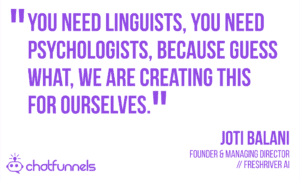
And so you start with that and go, Okay, so historically, we’ve used mobile and web right. Those have been the the emerging interfaces, which, frankly, is where you know, us humans have had to learn how to use that interface. Right. We have to train ourselves, you know, download an app, how do I use that interface. You know, conversational AI is
The first time that technology is coming to us as as human beings, right? So I always start with that when I’m educating my clients. So you cannot think about this, as a mobile and web interface, because customer expectations are completely different. Be there your employees or your clients, right.
So how are you going to do that? While still trying to solve those business problems? Right? So that’s where we typically start the conversation. And it gets some thinking to say, Okay, which one do I use? You know, the number one question I always get for my clients is, you know, what’s the best use case?
And that, to me, is the most important conversation to have because you don’t want to go solve the wrong problem, because then the bot won’t work. And they’ll say, well, the chat bots don’t work for us, right? So you know, you start there and you also have to think about the revolution chat bots have already gone through, right. 2016 they’ve been trending, everybody got in because it’s so easy to create ones, everybody and their brother was trading it
There are 100,000 bots that are littered on Facebook that failed. And when I looked at them, and I tried several and I said, you know, there’s something missing, there’s, no thought in creating enterprise grade, service, right? You wouldn’t go just haphazardly go create a mobile app, right for an enterprise as large as you know, Citigroup, or American Red Cross or any of these big giants.
And so you have to apply the discipline and the structure. And the whole framework starts from the use case> What problem are we trying to solve? Because not all problems can be solved with chatbots. Right? And after you’ve agreed upon that, you say, Okay, what persona sre you trying to solve this for? Because you could have a persona, either of the stakeholder, the customer, the user, if you give it to a developer, they’re just going to try and guess. So, you have to pay attention to that because that’s where design comes in. Interestingly enough, goes back to the question you actually started with, is You know, what’s the difference?
The big difference is, you need more than just a business analyst or developer, you know, the standard fare folks that get on a team to collaborate. You need linguists you need psychologists, because guess what, we are creating this for ourselves. How does a bot ask a question? And how do you respond back? Right? You have to think about all those things. There’s computational linguists that are involved in some of these teams. So that’s where I built up my ecosystem of folks because we need them. Or we’re going to have these failed bots.
Making Bots Conversational

Billy: Yeah, let me pause you. So this is what really, really caught me is you take this holistic approach to you know, we need linguist we need a psychologist, especially with voice because, you know, it’s one of the things that makes us human is really that we talk to each other and we share ideas and we communicate. So when you’re when you’re doing that you bring in a linguist and a psychologist to help with this. You know, like, can you dig into a little more like, where they’re providing value? What types of things they’re looking at? Because, you know, for us with our customers, you know, we don’t have any psychologist or linguist on our team.
We often just sit back to back and read through a bot flow and we’re, you know, the whole team will be there. And we’ll be like, you know, whoever’s being the bot will say, we’ll read a question. It’s like, all of a sudden, no, a person would never say that, you know? But, you know, like, that’s us. And we’re just trying to make it work because as people, but what value do they really, really bring and what problems do you sit them down and say, okay, solve this solve this problem?
Joti: Yeah. So first of all, the bot from a linguistic standpoint, if there are five people that are helping build it, and say two people who are testing it, Guess whose perspective is going to be in the bot? It’s going to be those folks and their perspective. You need diversity, number one, right? So that usually comes from people don’t have, you know, endless amounts of money to spend on resources here. So there’s a methodology there as well.
To answer your question about what value a linguist adds, think about it this way, I’ll give you a great example. Supposing the bot is designed to ask the question of the user saying, Would you like to do a, b or c? And the user says, Yes. What does that mean? That means we didn’t ask the question correctly. You have got to design it to think about it.
That’s where linguists come in. Linguists, usually when I’ve worked on projects with them, they’ll say, look, there are conversation terms. By the way, humans to humans don’t talk like human to bot. its a big difference. So there has to be thought to say, if you’re trying to help a human either transact, right because typically bots will do one of two things. They’ll either help you with an FAQ type question. Right? And or, they will help you transact, you know, what’s my checking account? They will connect them to, for example, a financial platform at the background. Right? How do you construct a question so that you can quickly get a response out up to the customer? If it’s very transactional, you know, it’s a financial bot, or it’s a retail bot.
You want to think about experiences. So the linguist will tell you, you know, if you’re trying to ask the question, you don’t want to have to take eight turns before the poor user gets, for example, what’s my checking account? You want them to get the answer really quickly. So how you ask the question is extremely critical. That’s just an example. So, it’s funny, you know, usually when you start with the bot, you go, okay, we’ve got five people sitting out of the room. Yes, you will write it out. You’ll play roleplay and you will have a flow you could use, you know, there’s plenty of tools out there to design. But when you’re doing that,
Are you wearing the shoe, or the hat of the user persona? Like in a retail bot, like there’s one luxury retail example I’d love to give. You take a luxury brand, and you say, Okay, I want to build a bot for them. What persona? Are you building it for? Are you building it for a 25-year old female trendsetter? Or are you building it for a guy coming on there to look for a gift for his, his wife or his girlfriend? Different. How would you ask a question? How would you use that language?
You would have to go study, what is the culture around that language? Because the people coming into that luxury retail bot would use specific terms. They may want to see who has been wearing, you know, the latest celebrity. Only then can you actually train the bot. Because it’s the expectation. Does that make sense?
Billy: Yeah, no, this is, this is great. And it’s one of the challenges I think a lot of us have when we’re building bots is, you know, how do we write the questions in a way that really leads into the answers that we can handle. you know, the bot wants. Huge challenge, and I could see how a linguist would help with that big time. So, as you’re going down through a deployment with the company identify a use case. What’s next?
Taking Action
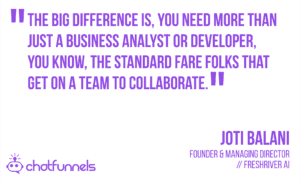
Joti: So we’ve got the use case go through design, you’ve got your linguist on your team. You know, a psychologist where it matters, you have to do a lot of research. So I’ll give you an example of an internal bot that I built out. You got to think about your stakeholders. You’ve got sales folks, you’ve got internal teams, you got HR, you got a lot of folks inside a company, right?
What’s their journey? What’s the journey map for that design? If a salesperson is trying to execute a deal, they need access to the content, say they need access to policy documents they need access to the platforms. You got to think about what the feature sets are going to add to that bot, and you can’t try to boil a whole ocean. So usually do a crawl walk run, you say what is the MVP? The minimum viable product of this bot that we’re going to start with day one, that’s meaningful enough.
The question, you know, well where’s ROI? I say, okay, the ROIs are going to be based on the problem with select to solve. And then you have to be very clear about who you’re solving it for, and understand their journey, because you want to get them from point A to point B in their journey. Because if it takes them longer to ask the bot the question than a human, then the bot has failed.
So these conversations happen in that phase of, you know, use case identification, the research, and then the design flow. And what I like to typically do is show them a mock-up. you know, using a tool like bot society, for example, right? I like to design. And I will give them a teaser show to say, this is what it’s going to look like. Just so that people can see, touch and feel, right.
That’s the thing with enterprises, they want to see what their product is like and show me a demo. So before I even have a developer write one line of code, I will show them this is roughly about what it’s going to look like. I’m going to do one or two FAQs, and I’ll show you the flow. That usually will tell me whether they’re Yep, this is the right direction or not. And then I will go off and, you know, further shape. And one of the things I would say is, for this persona, what are the top 10 questions that they will be, you know, want to ask about, and then we iterate. You know, the Agile part’s really important. You iterate and we build the first version of the bot, and we send it out to the first cohort of friendlies to test.
By the way, testing, another big topic. Crowdsource testing, automated testing. You need both. Because if humans are going to use this, you need to test it for the cohorts that you are designing the bot for.
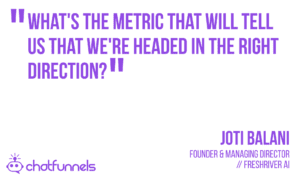
And then the analytics piece, right? So right up way front, when we’re talking about the use case and the problem, I’m always asking, what’s the metric that will tell us that we’re headed in the right
direction. And so you need an analytics tool in the framework that will measure that once you get it out.
Now, of course, say you built a bot, you deployed it into the channel, right be it website, or one of the social media channels, or it’s sitting by the way on top of an application on mobile or on web, internal or external. You need to actually market it. This is where I have the most fun because I have a marketing background as well. I actually can help my, my clients market it internally, if it’s an internal blog, or externally. Where should you deploy it? You know, if you’re going after a certain kind of user, where do they live and play and work. You want to make sure you’re deploying it there, at the point where they’re going to need it.
The most popular one that’s coming out in this strange times we’re living in; are customer service bots. They are front end, they’re becoming level one support for live agents, because a live agent cannot keep up with the barrage that’s coming in.
Choose a Single Metric
Billy: So absolutely, we’ve I’ve definitely seen this trend with our own customers that helping them build and deploy bots to manage customer service. Huge push in the last couple months. So I want to circle back, because you covered a lot of things, and there’s a few things I wanted to dig in just a little bit on you. So, measuring success.
You mentioned picking a single metric. Now I wondered if you could just expand a little bit on this because this is something that I think everyone, until you get it right, it is hard. Okay, we’ve launched this bot, it’s successful. Some use cases, it’s very obvious what that metric will be for measuring success. Others, not so much. But how do you help your clients pick that metric?
Joti: So, depends on the use case. And also the problem that we selected to solve. It has to be very, very specific. So if it’s going to be productivity, and we would say, how long did the bot take to get the response up to a user, that would typically have taken them without the bot? I always do a two day analysis. So for the problem that we select to solve, like, Well, how do they do it today? Example, going back to the salesperson who was looking for information trying to access platforms.
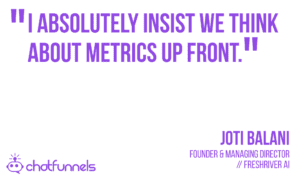
We can calculate, based on their job description, right? They go to visit, you know, four websites, internally access three systems. And of course, what they do is they pick up the phone and they call another human who is absolutely not set up to have, you know, 100 salespeople. Answer the question. So we have a before picture.
For HR, so let’s talk about an onboarding bot. How long does it take somebody to get onboarded? What’s your, you know, attrition rate. Because you know, people are just overwhelmed, they cannot find stuff, you know, information and access to systems to do their jobs in the most effective way. If a bot reduced the time it took you to access information, say even by 10 minutes, or 20 minutes a day, that is translating to time to revenue, right?
Even though you might say it’s time to response, but, you know, keep playing that, keep playing that out. If If a salesperson calls another good person who has to go do all that work for them, but they asked the bot the question. They could go execute q to deal much faster than somebody else that you know, financial example.
There’s many, many examples this way. So I always do a before and after. Because if you cannot do that, I cannot prove the bot is successful. If somebody says, is your bot successful? I’m like, I can’t tell you because we didn’t select the metric. And I absolutely insist we think about metrics up front. We don’t go crazy with it. But I said you should at least have one to two, to get started.
Progress is inevitable
By the way, very important thing, is the expectation that when you’re building the bot, you can save it. You first when you launch it, it’s an infant. And you keep training it and growing it and nurturing it till it becomes a toddler. And that’s my view is that currently, the technology out there is, you know, toddler level, it’s going to get better. But even the metrics have to be in line with the fact that this is how best the technology is today.
So don’t expect that the metric is going to be that it’s going to bring in you know, a million dollars of revenue just yet. It’s not going to replace your salespeople. It’s going to augment them, it’s going to make them more productive, so they can close better deals.
Because you don’t have an army, you don’t need an army of people to produce reports. So you, it all comes back to understanding where the bot is going to serve the needs for the, for the end user.
Billy: I couldn’t agree with you more on that. You’ve got to pick one, no more than two metrics to outline, you know, how we’re going to define success and, and get that before and after picture. And you have to understand, I agree that the technology is like, it is kind of in that toddler level, like, there’s a lot of value.
But you know, people come and they’re like, Oh, I want this bot to do all of these things for me, and replace all of these people possibly. And I’m like, ah, you know, we can do a little we can do a lot of that and, you know, depending on what they want, but you also have to realize what it is and what it isn’t, and it’s not, you know, it’s not the machine from the Terminator or anything like this at this point.
Joti: Yes, yes, we’re fighting that, that the view that all the media that they hear about us.
I have educational conversations with them all the time, and I said, hey, let’s have a seat. Let’s go grab a coffee. Let me first tell you, you know what, what is the best that the bot can deliver today? You get better, but not day one. It gets better every time. So let me ask you then, on you know, we launch an MVP and it is like a like a baby. It’s crawling.
Billy: What is, how do you approach optimizing those bots and building them out? You know, once you’ve got an MVP in place that has enough traction to say, yeah, let’s keep working on this. Where do you what, what’s your process after that?
Joti: So the analytics tool is very critical here, right? We have to analyze transcripts, and it’s a very painstaking process. So, for many clients where you know, the bots taken off as large volumes. I kid you not, my team and I look through every single conversation. Because it’s so critical to say, hey, the assumptions we made upfront of the persona of the problem that we’re trying to solve. Are people using the bot the way we intended to? Or are they asking for more things? So one of two things happen, right?
When you review the transcripts, you say, okay, did the bot go off the rails? How many false positives? How many false negatives, right, you got all of that stuff. But then the goldmine is, they’re asking for things that help inform your roadmap.
If somebody asks for, you know, we build safe features ABC, but somebody asked me for feature D, your bot should know that it does not know D, and respond gracefully. So error handling. So there’s happy paths, which, you know, web and mobile apps, you can do that all day long. Because, you know, humans have to figure out how to navigate.
But here, you need to know when you have to give the right answer. So that’s what we look for, we start to have a taxonomy framework, where we would look through all the transcripts and say, where are we headed? And, you know, tag all the taxonomy labels to them, and then do the analysis to say which percentages are following where. Really take a hard look at the we get the MVP close enough.
And then now, where do we need to retrain it? Where do we train it? Because there are some, you know, there’s taxonomy that are, excuse me, there’s vocabulary that we did not consider. The diversity of testing, right, that also informs us before we launch, because you want people asking questions in different ways. I will ask 10 different salespeople, Tell me how you would ask the question of this bot. And I will get 20 different ways that they would have asked that question. I got to go train the bot but you can’t do that endlessly.

So it’s like raising a child, you know, the more you teach the toddler, right, because infants can’t do much with them except drool and gargle. And we have a funny joke. It’s like, when the bot wouldn’t work, it’s like it’s drooling. Because there’s literally things coming out of its mouth, I suppose.
So you know, going back to your question, it’s really like, you’re like, you’re like a parent. So there’s co-parenting, and you’re looking at things to do right. Now, you know, this also depends on the platform you use to develop the bot. Some platforms will allow you, those levers to control thresholds of where the bot can make suggestions. Did you mean this or the other?
Or, that it has to be at the threshold of exact match. You could have bought that says I don’t know a lot of the times, which means you have made it too tight. You have made it too conservative.
Or you could make it too loose where the bot’s just answering questions in the wrong way. Both are desirable. So you’re always trying to figure out that lever that hopefully the bot platform gives you to control it. I’m not a fan of platforms that are completely you know, the it’s just set. You cannot customize them. I can’t control this, a lot of the black box ones are like that.
The other one’s a little bit harder. The open source ones are really good too, they’re the most flexible, but their GUIs are a little hard to work with. So yeah, there are companies all in the middle of that you know are giving you that sort of hybrid approach. So that also has to do a lot with is your MVP, the MVP you’re creating, is going to be you know, how can you control it? How can you train it awesome.
Tools For Conversational AI
Billy: Just before we before we break what tools do you like to use what’s your preference for analytics tools and building the bots?
Joti: Yes, I’m pretty agnostic. I’ve got in my ecosystem, you know, all sorts of partners because everybody’s innovating all the time. For analytics, the two I’ve worked with are bash bot and Bot Analytics. I’ve used Bot Society for, you know, designing and doing the mock-ups. I’ve used different platforms for bot development, everything from you know, core.ai to dialogue flow to Microsoft Bot Framework. And Alexa, we’ve built Alexa skills as well, you can just go off right now. And Rasa. So we’re actually close, my team and I taking a very close look at Rasa because I think it’s a very exciting platform that allows us the maximum flexibility.
And then there are testing tools. I’ve worked with Applause. We build out Selenium tests. And there’s whole bunch, right, depending on what they’re solving, but these are some of the very strong tools in my view, you know, that helped, you know, make make good progress on bots.
Billy: Awesome. Awesome. Well, Joti before, before we break, I’ve got one more question for you. Is there anything I should have asked you that I haven’t?
Joti: Um, so, you know, I think part of this is enterprises that are still trying to figure out whether they should do this or not. I get a lot of enterprises, you know, needing education in this. So, you know, what are the resources out there for people to learn more about bots? There’s tons of course, right? There’s a lot of courses. But there’s always a lot of noise. So how are we going to get enterprises, one to pay attention.
The other big thing I would tell you about and this is the work that I’m doing on open voice network. So I’m co-leading the strategist and designer community. And one of the things that we are injecting very strongly, I mentioned emotional intelligence, and that’s one very key part of the framework because, heck, this is for humans, right? Yeah. For the humans by the humans off the humans. And that is trademark. That’s my copyright. Okay?
Is ethics, trust, privacy, security, huge, huge topics. And we’re diving right into it to inform voice standards. So I highly encourage everybody to start to pay attention because our society, in the very near future, I would say, the next five years are going to be defined by how we build these conversational AI services out. It could go horribly wrong. So I think it’s, you know, all our responsibility to step in and participate.
Billy: Awesome. I agree. I agree. Especially on that education. Like, I don’t know how many companies we talked to that. They have one person who’s interested in the bot and everyone else is like, no they don’t work. And it’s like, well, if you think about it the right way they actually work. And it’s amazing to see, you know, you come out of a half hour an hour conversation, and once somebody understands what’s possible, and has the right expectations, they’re very open to trying it.
There is a lot of education that needs to take place and just, you know, having people ready to give it a shot. And then more people ready to build these things and build them well.
Thank you, again, if people want to reach out and continue the conversation, what’s the best way for someone to get in contact with you?
Joti: LinkedIn, LinkedIn will be the best way.
Billy: Okay, awesome. Well, thank you again, Joti, and we’ll chat later.
Joti: Thanks so much. Really appreciate the opportunity.
